The Universality of Learning and Thinking
The bronze sculptures of Confucius and Einstein are the pride of Universiti Tunku Abdul Rahman. Located at the open space in front of the Heritage Hall, the sculptures symbolise the universality of learning and thinking with the convergence of wisdoms from both the East and the West.
The bronze sculptures of Confucius and Einstein depict two world renowned scholars from two different eras and cultures – an eminent philosopher from the East and a genius physicist from the West – seated facing each other pondering the next move in the mind-challenging game of chess.
The Confucius statue measures 183-cm tall, 82-cm wide and 100-cm long and weighs 300 kg; while the Einstein statue measures 168-cm tall, 76-cm wide and 119-cm long and weighs 280 kg. Weighing 120 kg, the chessboard measures 76-cm tall, 91-cm wide and 91-cm long. The statues are seated on a 46-cm tall, 147-cm wide and 800-cm long pedestal. The profound thoughts in the Universality of Learning and Thinking are simply inspiring. The inscription on the plaque reads:
|
Universality of Learning and Thinking
Is it anachronism when the East meets the West at a tropical campus with over twenty centuries apart? One is a sage in philosophy whose dialogue with his disciples has influenced generation after generation of people and shaped their outlook on life and their stand as mankind on earth. The other stands as a giant in science who has changed our view of time, space and the universe with his out-of-the-box ideas. In front of us is but a mind game animated by an azure sky and a stunning landscape with its stretch of mountains, verdant display of foliage, reflective ponds reminiscent of a tin mining past, and activity of egrets and herons. Engaged in dialogue here is neither the Analects nor the Theory of Relativity. It is about how to learn. Confucius: “He who learns but does not think is lost. He who thinks but does not learn is in great danger.” Einstein: “All of science is nothing more than the refinement of everyday thinking.” Without an endless exercise of thought and learning, how could both figures manage to stand tall and outshine their contemporaries and even posterity as models of faith and inspiration? Universiti Tunku Abdul Rahman, amid the constant convergence of civilisations, strives to contribute to the sustainable development of the humanities, science and technology with an unrelenting mind on progressiveness, ethics and sparks of wisdom from the Orient and the Occident. |
UTAR would like to acknowledge the contribution of the following:
- Tan Sri Dato’ Hew See Tong, Advisor of UTAR Planning and Development Committee, for the donation of the bronze sculptures
- Mr. Wang Chain Khiang, Faculty of Creative Industries, for the design of the bronze sculptures
- Professor Dr. Lim Chooi Kwa, Institute of Chinese Studies, for the Chinese inscriptions
- Mr Luke Lim Kar Loke, Faculty of Arts and Social Science, for the translation of the Chinese inscriptions into English version
拉曼大学文遗堂前的孔子及爱因斯坦铜像是本校的骄傲,象征着拉曼大学是一所学习与思考并重以及东西文化荟萃的大学。
孔子及爱因斯坦对弈的铜像描述着来自不同时代及文化的两位先贤——孔子,东方伟大的哲学家及爱因斯坦,西方天才物理学家,正面对面坐着对弈。
孔子铜像重300公斤,高183厘米,宽82厘米及长100厘米;爱因斯坦铜像重280公斤,高168厘米,宽76厘米及长119厘米;棋盘重120公斤,高76厘米,宽91厘米及长91厘米。两尊相互弈棋铜像下的基座高46厘米,宽147厘米及长800厘米。 意义深远的“学习与思考”哲理得以给人带来启发。石匾上的题字为:
|
学习与思考
是时空错搭?直教东西方伟人,相距二十多个世纪,偏邂逅在美丽的大学校园里,一是儒学宗师,一是科学泰斗,他们全球驰誉。仰望辽阔的蓝天,纵览漭漭大地:绿叶成荫,碧草如茵,远山含翠,潋滟的湖水,世事恍如,眼前棋局。在这里的话题,既非难懂的《相对论》,也非整部《论语》,只是有关如何学习。 孔子曰:“学而不思则罔,思而不学则殆。”
若非永不休止的学习与思考,他们一生的事迹,怎会如此璀璨无比,又泽被苍生,为后人楷模、典范,信念泉源,永远景仰不已?值此各种文明迅速交汇之际,拉曼大学将自强不息,承传优秀的道德伦理,吸取东西方圣哲的智慧,为科技与人文的发展贡献努力。 |
- 铜像敬赠者——拉曼大学发展委员会顾问丹斯里丘思东局绅
- 铜像设计者——拉曼大学创意产业学院黄振江讲师
- 石匾中文题字者——拉曼大学中华研究院林水檺教授
- 题字翻译(中译英)者——人文与社会科学学院林家乐讲师
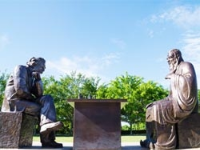
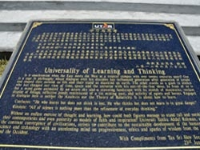
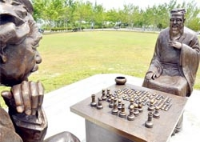
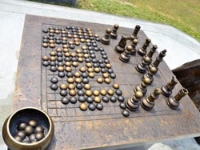
A game of chess infusing the East and the West
东西方交流的一局棋
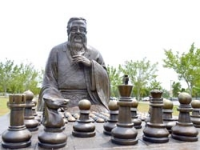
Confucius - an eminent philosopher from the East
孔子——东方伟大的哲学家
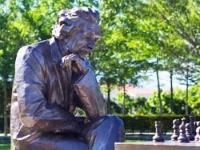
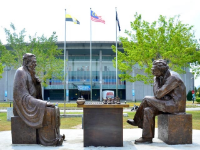
The sculptures in front of Heritage Hall
坐落在文遗堂前的孔子及爱因斯坦对弈铜像
